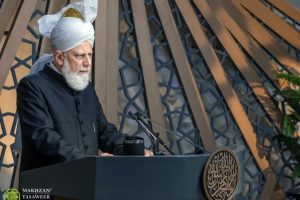
Munavara Ghauri
Recently Daniel Gee of the Farnham Herald interviewed the Worldwide Head of the Ahmadiyya Muslim Community, His Holiness, Hazrat Mirza Masroor Ahmad (aba).[1]Concerning the rights of Muslim women and the reason why men and women are segregated at Ahmadiyya Muslim events, His Holiness (aba) said:
“Separate venue, not value. Separate halls or marquees for women and for men, but the values are the same and the separate place has nothing to do with their teaching, their skills, their potential.”
Indeed, the gatherings and events of this Muslim Association are always organised and hosted independently by the men’s and women’s respective auxiliary associations. Ahmadi men and women also choose to socialise separately both in and outside the home, in accordance with Islamic teachings and the practice of the Holy Prophet Muhammad (sa). This is by no means a form of female entrapment. Rather, it is an acknowledgement that the sexes can relax, excel and feel safer by creating a social circle of their families and friends of the same gender only. It aligns with a growing feeling and demand in modern society for the creation of more public ‘safe spaces’ to assist women. For example, UN Women, is one organisation that is striving to improve the infrastructure of public parks with better lighting and pedestrian pathways. This project as well as other commendable initiatives were sparked by an international survey of Middle Eastern and North African countries, which revealed that between 40-60% of women had experienced street-based sexual harassment.[2] Furthermore, in 2018, Sweden’s most popular music festival, the Bravalla festival, cancelled the event and launched its first ‘non-male festival’ after shocking numbers of rape and sexual assaults were reported in its previous 2 gigs.[3]
Interesting research by Yue Qian, an assistant professor of sociology at the University of British Colombia, revealed that ‘…women are much happier when they work with other women, as opposed to men.’[4] Qian stated that when women worked in environments with over 90% male workers, there was a 52% increase in the ‘unpleasant feelings’ that they experienced. Conversely, a gender ratio change at work hardly affected men. Although Qian herself does not endorse gender segregation at work, her findings that heightened ‘unpleasant feelings’ could affect the health and longevity of a person indicate that gender segregation in the workplace may be preferred by some non-Muslim women also. Such preferences may not be expressed due to a variety of factors such as economics, career aspirations or a fear of social ostracism. However, it is interesting to reflect that there is always a universal expectation and preference for segregation in certain scenarios such as prisons and hospital wards. Since April 2011, hospital trusts in the UK can be fined £250 for keeping a patient on a mixed ward.[5] Thus, the majority of people do prefer same-gender environments in certain contexts, regardless of culture or creed.
His Holiness (aba) continued to explain why gender segregation is a positive experience for the women of the Ahmadiyya Muslim Community:
‘Our women feel that, according to our teaching, if they hold their meetings separately and without the umbrella or shadow of men, they can do better.’
In actuality, Ahmadi Muslim women are often highly educated and professionals and belong to a Community that has been described as ‘…the most educated, organised and disciplined of all Muslim communities in Britain.’[6] They embrace the teachings of the Holy Prophet (sa) of Islam, who stressed the importance of the acquisition of knowledge to all his followers, male and female. His teachings include that:
‘It is the duty of every Muslim man and woman to seek knowledge.’ (Ibni Majah)[7]
Furthermore, the Holy Prophet(sa) actively encouraged his wives to enhance their knowledge and did not feel threatened by their intellects and natural faculties. His first wife, Hazrat Khadija (ra), was a successful and established business woman prior to their marriage. The Holy Prophet (sa) employed a tutor to teach his wife – Hazrat Hafsah (ra) to write and learn certain aspects of medicine.[8]Indeed, this was a very progressive step if we consider that the Holy Prophet(sa) himself was illiterate, as were the majority of his contemporaries. He also acknowledged his wife, Hazrat Ayesha (ra), to be an Islamic authority when he declared to his followers: ‘You can learn half the faith from Ayesha.’[9]
His Holiness (aba) substantiated the high academic levels of the female members of the Ahmadiyya Muslim Community today by citing the fact that the current Head of the women’s auxiliary association (Lajna Imaillah), is in fact a practising GP in London. Ahmadi Muslim women do not perceive their segregation from men as a form of suppression. Rather, they see it as a means of empowerment and autonomy. Furthermore, anyone who has visited the International Annual Convention (Jalsa Salana) hosted by the Community each year in the leafy grasslands of Alton, Hampshire, a convention which has numbered close to 40,000 participants over the last few years and has become the largest Muslim gathering in the UK[10], will have seen the independent and expertise management of the women’s area by the female members. From serving food to administering First Aid, manning cameras as well as providing translations in at least half a dozen languages; there is no role that the ladies of this Community shirk. They are an incredibly efficient workforce, which also has the empathy and compassion to engage with all women, Muslim and non-Muslim. Each year, I am proud to label myself as part of that workforce – of Lajna Imaillah. Furthermore, as a British Ahmadi Muslim woman, I feel I fully integrate in society whilst still upholding Islamic values. I enjoy working in a local boys’ Grammar School with almost a 1,000 male students. I provide support for the pupils in the bustling school library and I am pleased to reflect that I may have altered the stereotypical notions of many of the pupils regarding Muslim women. However, there is a form of social segregation in Islam that I opt to maintain, hence I do not socialise with male colleagues outside the school gates. This is fundamentally because of my values and lifestyle as a member of Lajna Imaillah.
This ladies’ auxiliary association of the Community was established in 1922 by the Second Spiritual Head of the Community – His Holiness Hazrat Mirza Bashir-ud-Din Mahmood Ahmad (ra), who understood that the renaissance of the true teachings of Islam was only possible if women – half the membership, were equally involved. He said:
‘In order to fulfil the objectives of our creation the efforts of our women are equally necessary to the effort of our men.’[11] Furthermore, he also believed that the spiritual and intellectual progress of women, the fundamental objectives of the group, could be more effectively accomplished by other women. Hence, the ladies of this auxiliary group feel that the power and influence of women are acknowledged and appreciated by the Ahmadiyya Muslim Community within Islam.
Muslim women were in fact granted comprehensive rights by Islam 1400 years ago, such as the rights of inheritance, choosing a marriage partner, divorce, alimony and a political vote. Such a right was being fought for in the U.K. and other western countries as recently as the turn of the 20th century by Suffragettes like Emily Davison, who tragically lost her life campaigning for the right to vote. Similarly, it took over a century of passionate protesting before the 19th Amendment was ratified by the US Congress in 1920, allowing women the right to vote. Likewise, the largest organisation of female activists in the U.S. currently, the National Organization for Women (NOW), which has 500,000 contributing members, has a ‘Love Your Body’ campaign at present. It challenges the notion that ‘A woman’s value is best measured through her willingness and ability to embody current beauty standards.’[12] This concept had already been challenged by the revolution which the Islamic faith brought to the ignorant Arab peoples in the 6thCentury. By the very introduction of ‘purdah’ or the covering of their heads and bodies, Muslim women were liberating themselves from any crude assessments of their physical attributes and indeed how much they lived up to ‘current beauty standards.’
His Holiness, Hazrat Mirza Masroor Ahmad (aba), further elaborated upon the beautiful wisdom behind the Islamic teachings of segregation whilst being interviewed by a journalist on his recent tour of Germany in October 2019:
‘We do not deny the rights of women to get (an) education. If a woman is educated, she is an engineer, or a doctor or a lawyer, or a teacher or any other profession. They do go outside and do perform their duties and do their jobs…We believe that women can flourish better without the shade of men. So if they are separate, they are free to grow. You see, if you plant a small tree under a big tree, it cannot grow…’[13]
His Holiness’s (aba) view that girls and women actually flourish in a single-sex environment is supported by the multitude of teachers and parents who support single-sex schools and believe them to be a preferable learning environment for girls. An article in ‘the educator Australia’ last year reported interesting findings from research by Cornell University, U.S.A. It concluded that teenage girls do worse in their education, careers and social lives, when they have more high-achieving boys in their lessons. Conversely, girls seem to achieve better results in maths and science and are more likely to complete a bachelor’s degree when they have high-achieving girls in their classrooms. Furthermore, the greater the exposure to high-achieving boys meant a greater drop in girls’ self-confidence and aspirations. Alarmingly, the probability of ‘risky behaviour’ amongst girls with life-changing consequences also increased:
‘The higher the proportion of high-achieving boys, the lower the girls’ maths and science grades, the less likely they were to complete a bachelor’s degree, and the more likely they were to engage in risky behaviour, including teen pregnancy. On the other hand, boys were not affected by exposure to high-achievers of either gender.’[14]
Whilst the pros and cons of single-sex education can be eternally debated, it seems more a case of popular social norms causing resistance to the segregation of students as science itself proves that girls and boys have physiological differences that can affect their learning outcomes. In a primary school in Manning, South Carolina, two teachers decided to segregate their pupils according to gender for lessons after consulting David Chadwell, South Carolina’s coordinator for single gender education. Chadwell advised how medical technology has demonstrated that girls and boys perceive the world differently and hence learn in different ways. Girls are more drawn to warmer colours and textures than boys and faces rather than moving objects. Girls do not require a teacher to walk around as much as boys to remain engaged in learning. Interestingly, girls also have a more finely tuned aural structure, hence they can hear higher frequencies than boys and are more sensitive to sounds. Consequently, they may interpret what boys perceive to be a loud tone in a teacher as yelling.[15]
It seems evident why girls and indeed boys would flourish in segregated educational institutions and this ethos of allowing the genders to develop separately is that of the Ahmadiyya Muslim Community. Other all-female organisations also recognise the shared traits and sensibilities of women which unite them. The Girl Guides, founded in 1909, has opted to remain a girls-only organisation in the UK. It seeks to teach girls and young women the value of domestic skills and a kind of ‘practical feminism’[16] embodying survival skills and good citizenship, and it is a group that my daughter also enjoyed for several years. The Mother’s Union founded in 1876 is an international Christian movement supporting mothers to raise their families with Christian values and the National Council for Jewish Women (NCJW) champions the needs of women and social change. Whilst such faith groups may not always segregate their female members, the very fact of their existence suggests that the unique bonds amongst women should be valued. Ahmadi Muslim women cherish and celebrate these bonds and believe they do help them to ‘flourish better’.
[1]https://www.farnhamherald.com/article.cfm?id=139142
[2]https://www.unwomen.org/en/news/stories/2019/feature-story-building-safe-spaces
[3]9 rapes and 34 sexual assaults https://www.brumnotes.com/man-free-festivals-segregation-gender-deserves/
[4]https://qz.com/work/1478446/women-feel-better-when
[5]https://www.bbc.co.uk/news/health-12238401
[6]New Statesman, Aug 21st, 2006.
[7]Hazrat Mirza Bashir Ahmad, MA, Forty Gems of Beauty, (Tilford, Surrey: Islam International Publications, 2007), 165.
[8]Amtul Bari Nasir, Hadhrat Hafsa, (Tilford, Surrey: Islam International Publications, 2008), 6.
[9]Rahat Imtiaz, Ummul Momineen, Hadhrat Ayesha Siddiqa, (Tilford, Surrey: Islam International Publications, 2009), 3.
[10]https://en.m.wikipedia.org/wiki/Jalsa_Salana
[11]Lajna Section Central, The Constitution of The Lajna Imaillah Silsila ‘Aliya Ahmadiyya, published Lajna Section Central, 2019, 1.
[12]https://now.org/now-foundation/
[13]https://youtu.be/Kqm95Uj-2j8
[14]https://www.theeducatoronline.com/k12/news/girls-do-better-in-singlesex-schools-new-research/263225
[15]https://www.rd.com/advice/parenting/how-boys-and-girls-learn-differently/
[16]https://en.m.wikipedia.org/wiki/Girl_Guides




Add Comment